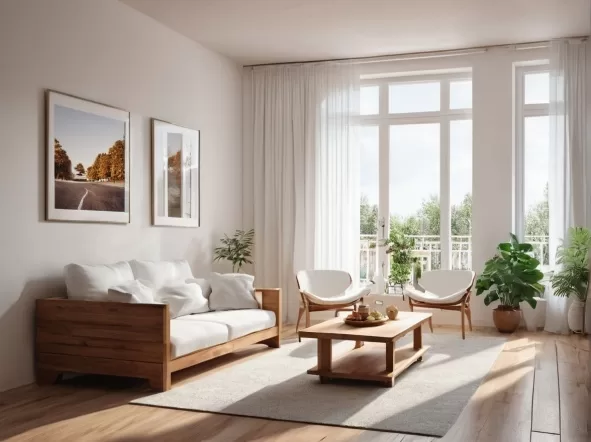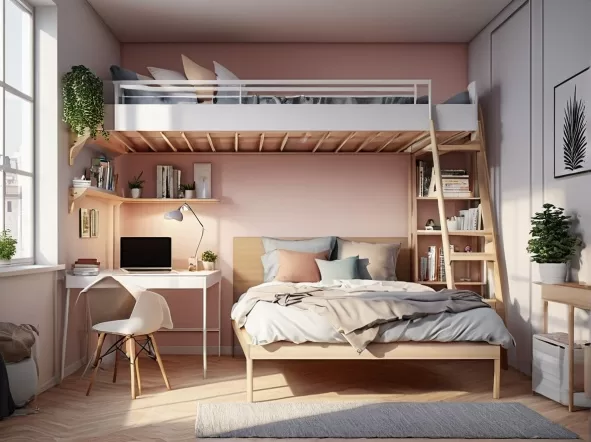7 Tricks to Make Your Small Room Look Bigger
Introduction
Living in a small space can be both a challenge and a joy. With the right approach, even the tiniest of rooms can be filled with style, comfort, and functionality. But let’s face it, a small room can quickly feel cramped, cluttered, and overwhelming. That’s where a bit of design magic comes into play. If you’re dealing with a compact bedroom, a snug living area, or a petite home office, the right tricks can help make your small room feel bigger.
In this post, I’ll walk you through some strategies that go beyond just decluttering and paint color. These tips will help you maximize every square inch of your space, making it look and feel much more expansive than it actually is. Ready to transform your space? Let’s dive in.
1. Use Light Colors and Clever Lighting
When it comes to making your small room feel bigger, one of the most effective tools at your disposal is color. The right palette can do wonders for the perception of space. Light colors, especially whites, soft neutrals, and pastels, reflect more light, making a room feel airy and open. Dark colors, on the other hand, tend to absorb light, which can make a room feel smaller and more enclosed.
Chose White Color
White is the ultimate space enhancer. It’s clean, crisp, and highly reflective, which helps to bounce light around the room. But don’t worry, white doesn’t have to be boring. By layering different shades of white and incorporating a variety of textures, you can add depth and interest to your space without sacrificing that expansive feel.

Strategic Lighting
Lighting plays a crucial role in how we perceive space. In a small room, you’ll want to avoid harsh, single-source lighting which can create stark shadows and make the room feel smaller. Instead, opt for layered lighting: a combination of ambient, task, and accent lighting. Wall-mounted sconces or pendant lights free up floor space while adding visual interest. Don’t forget to take advantage of natural light; keep window treatments light and airy to allow as much daylight in as possible.
2. Furniture That Multitasks
In a small room, every piece of furniture needs to earn its keep. Bulky, oversized furniture will dominate the space and make it feel smaller. Instead, look for pieces that are scaled to the room and serve multiple functions.
Choose Slim, Tall Furniture
Opt for furniture that is slim and tall rather than short and wide. This draws the eye upwards, emphasizing the height of the room rather than its limited floor space. For example, a tall bookcase or a slimline wardrobe can provide ample storage without overwhelming the room. When choosing a bed, consider one with built-in drawers or a loft bed with space underneath for a desk or seating area.

Multipurpose Furniture
Furniture that serves more than one purpose is a game-changer in small spaces. Think ottomans that double as storage bins, fold-out desks, or sofa beds. These pieces help you maximize functionality without crowding the room. Look for furniture that can be easily moved or reconfigured to suit different needs; for example, nesting tables that can be tucked away when not in use, or a dining table that can expand when guests are over.
3. Mirrors: The Illusion of Space
Mirrors are like windows you can place wherever you want. They reflect light and give the illusion of depth, making a small room feel bigger instantly. Large mirrors, or a series of smaller ones grouped together, can dramatically open up a space.
Placement is Key
Where you place your mirrors matters. Hanging a mirror opposite a window is the best way to maximize natural light, as it reflects the outdoors and enhances the sense of space. Alternatively, placing a mirror behind a piece of furniture, such as a sofa or bed, can create the illusion of added depth. Mirrored furniture or decor items, like mirrored side tables or cabinets, can also contribute to a more open and airy feel.
Mirrored Walls and Backsplashes
For a bolder approach, consider a mirrored wall or backsplash. In a small dining area or hallway, a mirrored wall can create the illusion that the space extends much further than it does. In the kitchen, a mirrored backsplash reflects light and gives the impression of more room.
4. Decluttering: Less is More
You’ve probably heard it before: decluttering is essential when trying to make a small room feel bigger. But decluttering is more than just tidying up, it’s about making conscious choices about what to keep and what to let go of.
Smart Storage Solutions
Clutter can quickly overwhelm a small space, making it feel cramped and chaotic. To combat this, invest in smart storage solutions that keep your belongings out of sight. Built-in storage, under-bed storage, and floating shelves can help you maintain a clean, organized space without taking up valuable floor space. Consider using storage boxes or baskets to keep items like remote controls, books, or toys neatly contained.
The Art of Minimalism
Embracing minimalism doesn’t mean your space has to be stark and devoid of personality. Instead, it’s about being intentional with your decor choices. Keep only the items that you truly love and that serve a purpose. A few carefully selected pieces can make a big impact without overwhelming the space. When every item has a place and a purpose, the room will naturally feel larger and more open.
5. Vertical Space is Your Best Friend
When floor space is limited, it’s time to start thinking vertically. Utilizing vertical space effectively can dramatically increase your storage options and make your small room feel bigger.
Floating Shelves and Wall-Mounted Storage
Floating shelves are a great way to add storage and display space without taking up floor space. They’re perfect for books, plants, and decorative items, and can be arranged in a variety of configurations to suit your style. Wall-mounted storage units, such as pegboards or rail systems, are also incredibly useful in small spaces, particularly in kitchens or home offices where you need to keep things organized and within reach.
Hang Your Curtains High
This is a classic trick that designers use to make a room feel taller and more spacious. By hanging curtains close to the ceiling, you draw the eye upward, creating the illusion of height. Pair this with long, flowing curtains that reach the floor for the best effect.
6. Opt for Glass and Lucite
Transparency is another key to making your small room feel bigger. Glass and lucite (acrylic) furniture pieces allow light to pass through, which means they take up less visual space in the room.
Glass Tables and Shelving
A glass coffee table, dining table, or shelving unit can give the illusion of a more open space. Because they don’t block your line of sight, these pieces help maintain the flow of the room, making it feel larger. Glass tables also reflect light, adding to the overall brightness and openness of the space.
Lucite Chairs and Accessories
Lucite or acrylic furniture, like chairs or accent tables, is perfect for small rooms. These pieces are practically invisible, which means they provide functionality without adding visual clutter. A lucite chair at a small desk, for example, can blend seamlessly into the room, making it feel less cramped.
7. Embrace an Open Layout
If your small room is part of a larger living area, consider an open layout. Removing barriers and opening up the space can make the entire area feel bigger.
Use Rugs to Define Spaces
In an open layout, rugs can help define different areas without the need for walls or dividers. A large rug under the seating area, for example, can delineate the living room from the dining area or kitchen. Choose rugs that are large enough to anchor the space but not so big that they overwhelm it.
Keep it Cohesive
When creating an open layout, it’s important to maintain a cohesive look throughout the space. Use a consistent color palette, and choose furniture and decor that complements each other. This will create a harmonious flow from one area to the next, making the entire space feel more expansive.
Conclusion
Making your small room feel bigger is all about strategic choices. By following these tips and tricks, you can create a room that not only looks bigger but feels bigger too. It’s about maximizing what you have, embracing clever design, and making your space work for you. With a bit of creativity and planning, you can turn even the smallest of rooms into a stylish, comfortable, and functional haven that you’ll love spending time in.
